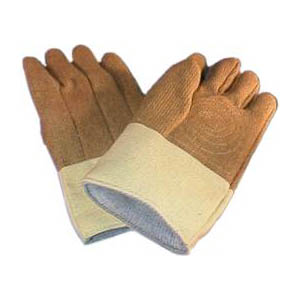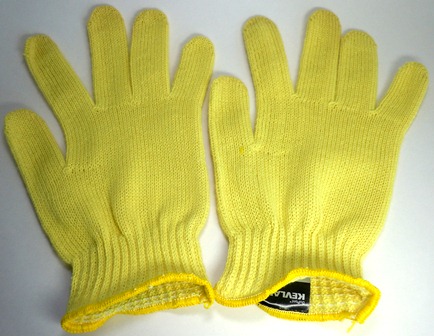 Heat resistant gloves and mitts
Heat resistant gloves and mitts
 Wear gloves when and where a reasonable chance exists of
your hands contacting something hot enough to cause a burn.
The hazard assessment should indicate cases where gloves are required.
There are some cases such as glassblowing, where the dexterity required cannot be achieved
wearing heavy gloves, but the properties of the materials permit handling them without injury.
Wear gloves when and where a reasonable chance exists of
your hands contacting something hot enough to cause a burn.
The hazard assessment should indicate cases where gloves are required.
There are some cases such as glassblowing, where the dexterity required cannot be achieved
wearing heavy gloves, but the properties of the materials permit handling them without injury.
 It is necessary that the gloves or mitts you choose
are adequate to protect you from the temperature of the items you may touch.
Keep in mind that most gloves are intended for contact with heated objects for a short time.
Fabric gloves and oven mitts provide short term protection at up to 200oC.
Kevlar knit work gloves give similar protection but are less bulky.
Kevlar PBI (Polybenzimidazole) gloves are useful at temperatures up to 900oC.
Consult the manufacturer's literature for the maximum temperature rating for the glove that you are using.
It is necessary that the gloves or mitts you choose
are adequate to protect you from the temperature of the items you may touch.
Keep in mind that most gloves are intended for contact with heated objects for a short time.
Fabric gloves and oven mitts provide short term protection at up to 200oC.
Kevlar knit work gloves give similar protection but are less bulky.
Kevlar PBI (Polybenzimidazole) gloves are useful at temperatures up to 900oC.
Consult the manufacturer's literature for the maximum temperature rating for the glove that you are using.
  don (put on) gloves and check for flaws, tears, holes.
The gloves should be a comfortable fit, but not so loose that they fall off.
don (put on) gloves and check for flaws, tears, holes.
The gloves should be a comfortable fit, but not so loose that they fall off.
When Removing (doff) gloves do not use your mouth to pull off gloves by the fingers.
Avoid gripping glove by an area that has just been in contact with a hot object while you are removing it.
One acceptable method is to partially remove one glove by pulling on the fingers, and with the fingers in the palm of the
partially removed glove pull off the other glove by the fingers. Then the partially removed glove may be shaken from the hand.
An alternative is simply to wait for the gloves to cool before removing them.
 Gloves will not allow contact with a hot object indefinitely.
Contact with objects above the maximum temperature limit for the glove will very quickly damage the glove,
and possibly cause a significant burn.
Some types of gloves may catch fire if subjected to a direct flame, or an object well above the
temperature limit for the glove.
The gloves intended for use at very high temperatures are also very expensive.
There are some operations where the dexterity required cannot be achieved with gloves rated for the temperatures
involved.
Gloves will not allow contact with a hot object indefinitely.
Contact with objects above the maximum temperature limit for the glove will very quickly damage the glove,
and possibly cause a significant burn.
Some types of gloves may catch fire if subjected to a direct flame, or an object well above the
temperature limit for the glove.
The gloves intended for use at very high temperatures are also very expensive.
There are some operations where the dexterity required cannot be achieved with gloves rated for the temperatures
involved.
 All gloves must be inspected before every use, for possible holes, tears,
weak areas.
Reusable gloves should be cleaned after each use if necessary, and stored so that
they may dry inside and out.
If your hands sweat, it is prudent to wear a light
disposable under reusable gloves to prevent their inside from becoming damp.
Most gloves can be cleaned with soap and water, but it is best to follow the manufacturers instructions if available.
The useful life of reusable gloves will vary drastically depending on the frequency of use,
the kind of use, and the conditions of cleaning and storage.
Used gloves can be disposed of as regular trash unless they have been contaminated with some hazardous material.
All gloves must be inspected before every use, for possible holes, tears,
weak areas.
Reusable gloves should be cleaned after each use if necessary, and stored so that
they may dry inside and out.
If your hands sweat, it is prudent to wear a light
disposable under reusable gloves to prevent their inside from becoming damp.
Most gloves can be cleaned with soap and water, but it is best to follow the manufacturers instructions if available.
The useful life of reusable gloves will vary drastically depending on the frequency of use,
the kind of use, and the conditions of cleaning and storage.
Used gloves can be disposed of as regular trash unless they have been contaminated with some hazardous material.
|






 Heat resistant gloves and mitts
Heat resistant gloves and mitts